Making of Tommi knives
| Making of Tommi knives | ||||
|---|---|---|---|---|
| In the national inventory | ||||
|
Practitioners and people who know the tradition well
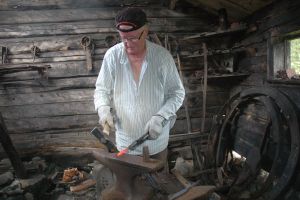
Tommi knives, or Tommi-puukkos in Finnish, have been forged in Hyrynsalmi since the late 19th century. The tradition has lived on in the hands of numerous knifemakers, who have passed it on from generation to generation. The skills and tradition of making Tommi knives have spread from Hyrynsalmi to the neighbouring municipalities, and the knife design is well-known in Kainuu and Koillismaa in particular. The Tommi knife is also an appreciated knife within national knife circles, and it is made throughout Finland today. An authentic Tommi knife is made by hand by a single person, from the forging of the blade to the sewing of the sheath.
Tommi-puukon Perinneyhdistys ry (Tommi Knife Heritage Association) was founded in Hyrynsalmi in 2002. The association’s goal is to maintain and strengthen the tradition of making Tommi knives. Most of the association’s members are knifemakers, experts in the making of Tommi knives, individuals otherwise interested in knife making culture or supporters of awareness of the tradition. Tommi-puukon Perinneyhdistys upholds knife making culture for all the people who respect the historical significance of Tommi knives as common utility items of the people and as a part of everyday culture.
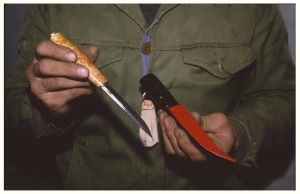
The Tommi knife is known throughout Finland as a practical and beautifully reduced knife design. The official Tommi knife designs are arki-Tommi (Everyday Tommi), juhla-Tommi (Festive Tommi), junki, akkain-Tommi (Women’s Tommi), jääkäri-Tommi (Jaeger Tommi) and tupla-Tommi (Double Tommi). Scientifically speaking, there is no one absolute Tommi knife, as the personal touch of the maker is visible in each and every knife. Here lies the strength of Tommi knives: an authentic Tommi knife is not made by an industrial robot, even tough that would be possible. A Tommi knife always has to be a unique, and even rough, demonstration of craftmanship that has its own charisma.
In some official contexts or studies, the Tommi knife has been referred to as the Kainuu knife (Kainuunpuukko or Kainuun Puukko), which is still used in many contexts. However, the knife’s real name is Tommi knife. This name is rooted in the knife’s history and in the name that took shape in the mouths of the people. In contrast, the Kainuu knife is more of a generic name assigned by the authorities or researchers, and it does not sit well in the people’s mouths. Some professional knifemakers who work as entrepreneurs in different parts of Finland may also talk about the Kainuu knife and mention the Tommi knife as a hyponym.
Practising of the tradition
The ability to make Tommi knives is widespread among the inhabitants of Hyrynsalmi. Hyrynsalmi Adult Education Centre has held courses on the making of Tommi knives for decades. People from all around Finland and even from abroad have also attended summer courses. The woodworking teachers of Hyrynsalmi Comprehensive School have studied under authentic makers of Tommi knifes in order to learn the knowledge and skills related to knife making. At woodworking courses taught at Hyrynsalmi Comprehensive School, every generation makes Tommi knifes, regardless of gender.
Tommi knife makers from Hyrynsalmi have won numerous Finnish championships and first place awards in Nordic knife making competitions. The winners have included both men and women, and both girls and boys in competitions for schoolchildren. The municipality of Hyrynsalmi is also strongly involved in promoting the Tommi knife culture. This manifests as the presenting of Tommi knifes as gifts to dignitaries who visit the municipality, among other things. In 2002, a traditional Tommi knife made by Pentti Kaartinen from Hyrynsalmi represented Finnish knives and craftmanship at an international design fair in Tokyo.
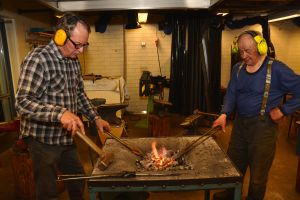
The reputation of the Tommi knife is based on its beautifully reduced shape, and the fact that it sits well in the hand allows it to be used for a variety of purposes. The culture of making Tommi knifes lives on strongly not only in Hyrynsalmi, Kainuu and Koillismaa but also throughout the country. However, the most valuable part of the Tommi knife culture is the fact that ordinary citizens, regardless of gender or age, forge Tommi knifes as a hobby, take joy in their craftmanship and are proud of their knowledge of the tradition.
There are hundreds of people in Kainuu who make Tommi knives as a hobby, and the knife making tradition is continued on at the level of everyday life. There are dozens of professional or semi-professional makers of Tommi knives. The makers of Tommi knives also include entrepreneurs who market the Tommi knife in their own name. Tommi knives are part of the gear of workers, hunters and hikers, and they are also used in conjunction with national costumes and prestigious events.
The background and history of the tradition
2014 marked the 170th anniversary of the birth of the Tommi knife’s ‘father’, Kalle Keränen (1844–1912). In honour of the anniversary year, Tommi-puukon Perinneyhdistys ry opened a Tommi knife exhibition at Hyrynsalmi Municipal Hall. The exhibition features an extensive collection of Tommi knives from different eras as well as materials related to iron making and blacksmith culture. 2019 marked the 175th anniversary of Kalle Keränen’s birth. Fiskars, where Kalle honed his skills, turned 370 that same year.
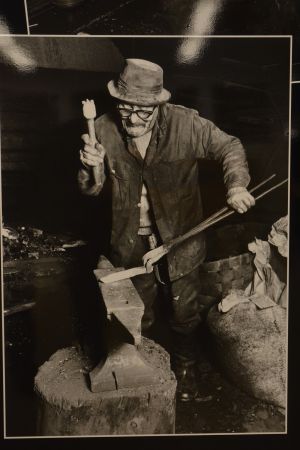
It is likely that knives had been made in Hyrynsalmi long before Kalle and that smithies were going strong. The highest number of huts related to iron making in Finland have been found in Hyrynsalmi. In other words, the population of Hyrynsalmi obtained their own iron with their own skills, which resulted in the locals developing a high level of skill in iron processing. The origins of the Tommi knife are linked to certain events in the history of Finland. The Famine of 1866–1868 led to inhabitants of Kainuu migrating south in search of a living. Home distillation was banned around the same time.
Joosua Jokelainen, a travelling coppersmith, started making various utility items out of stills that had become unnecessary. While travelling, he stopped by the house of smith Matti Keränen, which was located in Oravivaara, Hyrynsalmi. Jokelainen saw that the smith’s son, Kalle, was forging knifes and tempering them by immersing them in water. The coppersmith urged the boy to go south to the ‘great smithy’ of Fiskars. There, the young man would learn oil tempering, casting of bronze and the use of borax in soldering. Had he stayed in his home village, Kalle would have risked dying of hunger. Kalle Keränen packed up his things and started making his way south with beggars who were fleeing hunger. After roaming far and wide, he finally arrived at Fiskars, where Thomas Woodward from England had recently taken over as the head of the cutlery workshop.
After four years, in 1870, Kalle Keränen returned to his home village of Hyrynsalmi from Fiskars as a learned master, wearing shiny boots and with a gleaming pocket watch chain on his hip. He started a family, founded a smithy and began working as a multiskilled blacksmith. He was able to make cast bronze horse bells as well as belt buckles and buckles for horse harnesses. He also knew how to make iron decorations for church sleighs. Knives later became his key products. Keränen’s knives became popular thanks to their beautiful shape, practicality and sharp edges. The name Tommi knife is derived from Thomas ‘Tommi’ Woodward, whom Kalle Keränen liked to talk about and whom he sometimes compared himself against. People gradually started referring to Kalle as Tommi, and, through this, his knives as Tommi knives.
Kalle Keränen was still working as a blacksmith when he died at age 68 in 1912. His son, Setti Keränen (1877–1953), was a master worthy of his father. Setti particularly became well-known for the knives he made for Jaeger recruits. In 1916, when Finland was taking steps towards its independence, Tommi knives were forged day and night in Hyrynsalmi for Jaeger recruits who were leaving to train in Germany, as the eastern path taken by the recruits travelled via the Halla House in Hyrynsalmi to Haparanda and from there via Sweden to Germany.
Throughout the decades, Tommi knives were basic everyday tools. They were a part of life and no special attention was drawn to them – every man carried a sheathed Tommi knife on their hip. At some point, people noticed that there no longer were as many Tommi knives around as there used to be. Industrially made Mora knives gained ground in the 1960s and 1970s. Kalle Juntunen (1930–2018) noticed this and started to collect and research the history of the Tommi knife and interview knifemakers. He later set out to revive the knife culture, which was in danger of disappearing, and succeeded in this mission.
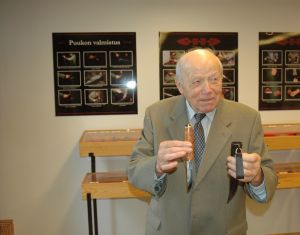
The transmission of the tradition
The making of Tommi knives is taught extensively in basic education and adult education centres. Cooperation has also been carried out with the Mustarinda Association, located in Hyrynsalmi, in the making of Tommi knives. Through Mustarinda, Tommi knives and the ability to make them have also spread abroad as a result of international artists discovering their beauty and practicality.
There are dozens of active makers in Hyrynsalmi. New makers are continuously being produced by courses and the teaching of woodworking at schools. There is a roundabout in the centre of Hyrynsalmi that features a sculpture called Vuolijat (Whitlers) by Leo Karsikas. It is a reference to the living Tommi knife tradition. The sculpture features the father knife lying on its side, while the son knife has its head raised towards the sky.
The Tommi knife has also been the subject of films and recordings made by both amateurs and professionals. There is a smithy at Kaunislehto House Museum in Hyrynsalmi, which hosts Tommi knife forging demonstrations in the summer. Magician and illusionist Henri Kemppainen, who was born in Hyrynsalmi and who was chosen as the Best Performer of 2016, performed magic tricks related to Tommi knives in front of the camera at Kaunislehto House Museum in winter 2017. This is part of his work, Magic in Lapland, that is intended for international distribution.
The Tommi knife as become a cult object that is applied for different purposes. The name of the Tommi knife is also utilised for marketing purposes. The Tommi knife has spawned several versions for the market that no longer necessarily meet the characteristics of a Tommi knife. This phenomenon is not necessarily negative for the tradition, as it also demonstrates the strength of the Tommi knife tradition, which can be applied for various purposes.
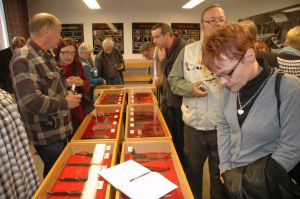
When it was noted that knives were starting to deviate wildly from Tommi’s idea of the knife’s shape, quality and naming, Tommi-puukon Perinneyhdistys set up a standardisation committee comprised of experts. Commissioned by the committee, Pentti Kaartinen prepared model Tommis that are on display in the Tommi knife exhibition at Hyrynsalmi Municipal Hall.
Tommi knives have won numerous Finnish championships and top places in other Nordic countries. The Tommi knife represented Finnish craftsmanship at an international design fair in Tokyo in 2002. A Tommi knife made by knifemaker Pentti Kaartinen from Hyrynsalmi was on display at this fair alongside works by Alvar Aalto, among others. Personal Tommi knives have been donated to President Urho Kekkonen, President Mauno Koivisto and President Sauli Niinistö as well as several foreign statesmen and stateswomen. President Kekkonen also liked to gift Tommi knives on his trips.
The future of the tradition
Among the practitioners of the tradition, there are still traditional blacksmiths advanced in years whose rough Tommi knives are cult objects. There are also Tommi makers whose works are displayed in the glass cabinets at jewellery stores. Additionally, it is a source of pride at Hyrynsalmi Comprehensive School that, every spring, all new graduates bring home a Tommi knife they have made themselves. The future of the Tommi knife tradition is also strong for these reasons. A success story that has continued for decades, over a century, tells us how strong local culture can be. Despite this, any tradition may be threatened today. The Tommi knife’s status as a tradition must be upheld in many ways to retain it not only as a tradition but also as a form of modern living culture. Tommi-puukon Perinneyhdistys and the work it carries out play a key role in the preservation and upholding of the Tommi knife tradition.
The community/communities behind this submission
Tommi-puukon Perinneyhdistys ry
Bibliography and links to external sources of information
Yle Uutiset: Puukkopitäjä saa vihdoin terät esille
Hyrynsalmen historia -book.
Kiitosvirsi-poem of Ilmari Kianto, to smith Setti Keränen in 1921.
Notes and interwievss of kotiseutuneuvos Kalle Juntunen.
Articles from 1990-2018.
A letter from President Urho Kekkonen till smith Antti Kemppainen, 1971.
Ruusuvuori, Anssi (2009) Puukon historia. Tampere: Apali Oy.
Recors of Tommi-puukon Perinneyhdistys.
Material of the Tommi-puukko -exhibition in Hyrynsalmi municipal house.
Tommi-knife -movies of Väinö Tauru .
